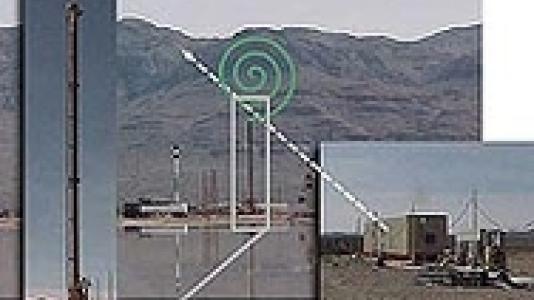
ARGONNE, Ill. – A new award-winning innovation developed at the Department of Energy’s Argonne National Laboratory can covertly detect chemical plumes at great distances and may help thwart future chemical or nuclear-based terrorist attacks. The technology has a number of other uses, as well, from detecting environmental pollution to determining the extent of tissue damage in burn victims without physical contact.
Passive millimeter-wave spectroscopy (PmmWS) was pioneered by Sami Gopalsami, Sasan Bakhtiari, Paul Raptis and Thomas Elmer, all of Argonne’s Nuclear Engineering Division. The technology has the capacity to identify chemical plumes at ranges of up to a few kilometers and at concentrations as low as 100-1000 ppm. This new technology was recently recognized with one of the 2007 R&D 100 awards, colloquially known as the “Oscars of invention.”
The Argonne team designed PmmWS primarily to monitor chemical signatures emitted by processing facilities suspected of unauthorized nuclear activity. Certain chemical fingerprints can identify factories involved in the enrichment and reprocessing of nuclear materials and their use in weapons production.
The researchers’ ability to collect remote data passively, like using an infrared camera, as opposed to actively, like using radar, provides a significant improvement over other chemical detection equipment. “The main concern is that there should be nothing to intercept,” said Gopalsami. “If you are my adversary, you can just put up some sort of receiver and see that I’m looking at you.”
“That was the number one requirement – you do not want to be transmitting any signal,” Bakhtiari added.
This new detection technology possesses several other advantages over other forms of chemical sensing. Previous remote sensing instruments for terrestrial, as opposed to astronomical, use had lower ranges of detection (ranging from 10 m to 100 m), were susceptible to interference from clouds and other atmospheric phenomena, and cost significantly more than PmmWS. Compared to it predecessors, the Argonne system is also safer and offers better selectivity – that is, it can identify a particular molecule instead of just a molecular functional group.
This passive remote-sensing spectrometer represents the second R&D 100 award-winning invention in millimeter-wave technology for the Gopalsami-led team. In 1996, the magazine recognized Gopalsami, Bakhtiari and Raptis for a millimeter-wave imager that could detect flaws in fabric during weaving. The design of that instrument provided part of the basis for their new product.



